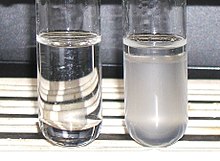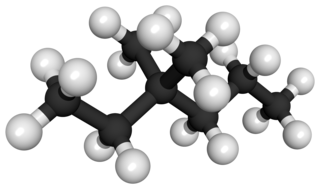
Comparison of psychoactive alcohols in alcoholic beverages.
Contents
The Lucas test in alcohols is a test to differentiate between primary, secondary, and tertiary alcohols.

Comparison of psychoactive alcohols in alcoholic beverages.
The Lucas test in alcohols is a test to differentiate between primary, secondary, and tertiary alcohols.
| IUPAC name | Common name | Classification | CAS |
|---|---|---|---|
| Ethanol | Alcohol, drinking alcohol, ethyl alcohol, EtOH | Primary | 64-17-5 |
| Propan-1-ol | 1-Propanol, 1-propyl alcohol, PrOH | Primary | 71-23-8 |
| 2-(1H-Indol-3-yl)ethanol | Tryptophol | Primary | 526-55-6 |
| 2-Methylbutan-1-ol | 2-Methyl-1-butanol (2M1B) | Secondary | 137-32-6 |
| 2-methylpropan-1-ol | 2-Methyl-1-propanol (2M1P), Isobutanol | Primary | 78-83-1 |
| 2-Methylbutan-2-ol | 2-Methyl-2-butanol (2M2B), tert-Amyl alcohol (TAA, tert-amylol) | Tertiary | 75-85-4 |
| 2-Methylpropan-2-ol | 2-Methyl-2-propanol (2M2P), tert-Butyl alcohol ((TBA), tert-butanol), t-BuOH | Tertiary | 75-65-0 |
| 2-Phenylethan-1-ol | Phenethyl alcohol, 2-Phenylethanol | Primary | 60-12-8 |
| 3-Methylbutan-1-ol | 3-methyl-1-butanol (3M1B), isoamyl alcohol, isopentyl alcohol (isopentanol) | Primary | 123-51-3 |
| IUPAC name | IARC carcinogen group | Toxic metabolite(s) | Alcohol by volume (ABV) [1] | LD50 in rat, oral [2] |
|---|---|---|---|---|
| Ethanol | Group 1 | Acetaldehyde → acetic acid | Up to 95.6% in rectified spirit | 7060 mg/kg |
| Propan-1-ol | Propionaldehyde → propionic acid | 2.8% (mean) in Jamaican rum: 2384–3130 mg/100 mL. Up to 3500 mg/L (0.35%) in spirits. [3] | 1870 mg/kg | |
| 2-(1H-Indol-3-yl)ethanol | ? | ? | ? | |
| 2-Methylbutan-1-ol | ? | 1.2% (mean) in Bourbon: 910–1390 mg/100 mL | 4170 mg/kg [4] | |
| 2-methylpropan-1-ol | ? | 0.9% (mean) in Rye mash cistern room: 534–1197 mg/100 mL | 2460 mg/kg | |
| 2-Methylbutan-2-ol | None (tertiary alcohol) | 0.07% in beer: 70 mg/100 mL (see tert-Pentyl alcohol in ref) Found in cassava fermented drinks | 1000 mg/kg | |
| 2-Methylpropan-2-ol | None (tertiary alcohol) | Identified, not quantified, in beer [5] | 2743 mg/kg | |
| 2-Phenylethan-1-ol | ? | 0.1% in non-yeasted cider (Kieser 1964): 100 mg/100 mL | 1790 mg/kg | |
| 3-Methylbutan-1-ol | ? | 1.5% (mean) in French Brandy: 859–2108 mg/100 mL | 1300 mg/kg |
| IUPAC name | % intoxication by alcoholic drink (ABV x potency compared to EtOH / total ABV) | Therapeutic index (Potency compared to EtOH/EtOH LD50:LD50 ratio) | Potency compared to EtOH | EtOH LD50:LD50 ratio |
|---|---|---|---|---|
| Ethanol | - | - | - | - |
| Propan-1-ol | 21%: 2,8×3÷40 | 0.8 (mean): 0.5-1.1 | 3 (mean): 2-4 | 3.8 |
| 2-(1H-Indol-3-yl)ethanol | ? | ? | ? | ? |
| 2-Methylbutan-1-ol | ? | ? | ? | 1.7 |
| 2-methylpropan-1-ol | ? | ? | ? | ? |
| 2-Methylbutan-2-ol | 28%: 0.07×20÷5 | 2.8 | 20 | 7.1 |
| 2-Methylpropan-2-ol | ? | ? | ? | 2.6 |
| 2-Phenylethan-1-ol | ? | ? | ? | ? |
| 3-Methylbutan-1-ol | ? | ? | ? | 5.4 |
| IUPAC name | Color/Form [6] | Odor [6] | Taste [6] |
|---|---|---|---|
| Ethanol | Clear, colorless, very mobile liquid | Mild, rather pleasant; like wine or whiskey. Weak, ethereal, vinous odor. | Burning, slightly sweet |
| Propan-1-ol | Colorless liquid | Similar to ethanol | Characteristic ripe, fruity flavor. Burning taste |
| 2-(1H-Indol-3-yl)ethanol | ? | ? | ? |
| 2-Methylbutan-1-ol | Oily, clear liquid. Colorless liquid | Characteristic, disagreeable odor. | Pungent, repulsive taste |
| 2-methylpropane-1-ol | Colorless, oily liquid. Clear, colorless, refractive, mobile liquid. | Suffocating odor of fusel oil. Slightly suffocating; nonresidual alcoholic. Sweet, musty odor | Sweet whiskey taste |
| 2-Methylbutan-2-ol | Colorless liquid | Characteristic odor. Camphor odor | Burning taste |
| 2-Methylpropan-2-ol | Colorless liquid or solid (crystals) (above 78 degrees F) | Camphor-like odor | ? |
| 2-Phenylethan-1-ol | ? | Intense odour of roses | Burning |
| 3-Methylbutan-1-ol | Oily, clear liquid. Colorless liquid. | Characteristic, disagreeable odor. | Pungent, repulsive taste |

Ethyl carbamate (also called urethane) is an organic compound with the formula CH3CH2OC(O)NH2. It is an ester of carbamic acid and a white solid. Despite its name, it is not a component of polyurethanes. Because it is a carcinogen, it is rarely used, but naturally forms in low quantities in many types of fermented foods and drinks.
Cold water extraction is the process whereby a substance is extracted from a mixture via cold water. It is a type of fractional crystallization.

Ampyrone is a metabolite of aminopyrine with analgesic, anti-inflammatory, and antipyretic properties. Its use as a drug is discouraged due to the risk of agranulocytosis. It is used as a reagent for biochemical reactions producing peroxides or phenols. Ampyrone stimulates liver microsomes and is also used to measure extracellular water.

Ammonium ferric citrate has the formula [NH+4]5[Fe(C6H4O7)2]5−. The iron in this compound is trivalent. All three carboxyl groups and the central hydroxyl group of citric acid are deprotonated. A distinguishing feature of this compound is that it is very soluble in water, in contrast to ferric citrate which is not very soluble.

Disodium citrate, also known as disodium hydrogen citrate, Alkacitron, and sesquihydrate, is an acid salt of citric acid with the chemical formula Na2C6H6O7. It is used as an antioxidant in food and to improve the effects of other antioxidants. It is also used as an acidity regulator and sequestrant. Typical products include gelatin, jam, sweets, ice cream, carbonated beverages, milk powder, wine, and processed cheeses.

Thymol blue (thymolsulfonephthalein) is a brownish-green or reddish-brown crystalline powder that is used as a pH indicator. It is insoluble in water but soluble in alcohol and dilute alkali solutions.

3-Pentanol is one of the eight isomers of amyl alcohol. It is found naturally and has a role as a pheromone.

Fluorenol, also known as hydrafinil, is an alcohol derivative of fluorene. In the most significant isomer, fluoren-9-ol or 9-hydroxyfluorene, the hydroxy group is located on the bridging carbon between the two benzene rings. Hydroxyfluorene can be converted to fluorenone by oxidation. It is a white-cream colored solid at room temperature.

Demeton, sold as an amber oily liquid with a sulphur like odour under the name Systox, is an organophosphate derivative causing irritability and shortness of breath to individuals repeatedly exposed. It was used as a phosphorothioate insecticide and acaricide and has the chemical formula C8H19O3PS2. Although it was previously used as an insecticide, it is now largely obsolete due to its relatively high toxicity to humans. Demeton consists of two components, demeton-S and demeton-O in a ratio of approximately 2:1 respectively. The chemical structure of demeton is closely related to military nerve agents such as VX and a derivative with one of the ethoxy groups replaced by methyl was investigated by both the US and Soviet chemical-weapons programs under the names V.sub.X and GD-7.

In chemistry, methanetetracarboxylate is a tetravalent anion with formula C5O4−8 or C(−CO−2)4. It has four carboxylate groups attached to a central carbon atom; so it has the same carbon backbone as neopentane. It is an oxocarbon anion, that is, consists only of carbon and oxygen.
Neoendorphins are a group of endogenous opioid peptides derived from the proteolytic cleavage of prodynorphin. They include α-neoendorphin and β-neoendorphin. The α-neoendorphin is present in greater amounts in the brain than β-neoendorphin. Both are products of the dynorphin gene, which also expresses dynorphin A, dynorphin A-(1-8), and dynorphin B. These opioid neurotransmitters are especially active in Central Nervous System receptors, whose primary function is pain sensation. These peptides all have the consensus amino acid sequence of Try-Gly-Gly-Phe-Met (met-enkephalin) or Tyr-Gly-Gly-Phe-Leu ( leu-enkephalin). Binding of neoendorphins to opioid receptors (OPR), in the dorsal root ganglion (DRG) neurons results in the reduction of time of calcium-dependent action potential. The α-neoendorphins bind OPRD1(delta), OPRK1(kappa), and OPRM1 (mu) and β-neoendorphin bind OPRK1.

Methoxyethylmercuric acetate is a chemical compound formerly used as a pesticide for seeds of cotton and small grains. It is highly toxic, and can pose a threat to the brain and central nervous system.

A dibromoanthracene is a derivative of anthracene with two bromine atoms. All compounds have the formula C14H8Br2. They are all isomers of one another.

3,3-Dimethylhexane is a colourless, odourless liquid, chemical compound in the family of hydrocarbons which has a formula of C8H18. It is an isomer of octane, where two methylene hydrogens at the third position in a hexane molecule have been replaced with two methyl groups.

C12-C14 alcohol glycidyl ether (AGE) is an organic chemical in the glycidyl ether family. It is a mixture of mainly 12 and 14 carbon chain alcohols, also called fatty alcohols that have been glycidated. It is an industrial chemical used as a surfactant but primarily for epoxy resin viscosity reduction. It has the CAS number 68609-97-2 but the IUPAC name is more complex as it is a mixture and is 2-(dodecoxymethyl)oxirane;2-(tetradecoxymethyl)oxirane;2-(tridecoxymethyl)oxirane. Other names include dodecyl and tetradecyl glycidyl ethers and alkyl (C12-C14) glycidyl ether.

Diglycidyl resorcinol ether, also called Resorcinol diglycidyl ether (RDGE) is a liquid aromatic organic chemical compound and chemically a glycidyl ether.

EA-1763, O-PPVX, V1 or propyl S-2-diisopropylaminoethylmethylphosphonothiolate, is a military-grade neurotoxic organophosphonate nerve agent related to VX. It is part of the V-series. The substitution of a proton for methyl makes its properties more similar to those of VX.
Alkali citrate is an inhibitor of kidney stones. It is used to increase urine citrate levels - this prevents calcium oxalate stones by binding to calcium and inhibiting its binding to oxalate. It is also used to increase urine pH - this prevents uric acid stones and cystine stones.